
Browse an alphabetical list of photographs. These historical images portray people, places, and events before, during, and after World War II and the Holocaust.
<< Previous | Displaying results 76-100 of 345 for "Photo" | Next >>
A pile of corpses in the Buchenwald concentration camp after liberation. Buchenwald, Germany, May 1945. Together with its many satellite camps, Buchenwald was one of the largest concentration camps established within the old German borders of 1937.
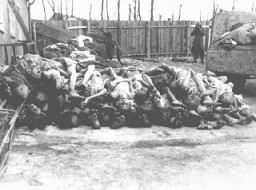
A pile of corpses at the Russian Camp (Hospital Camp) section of the Mauthausen concentration camp after liberation. Mauthausen, Austria, May 5-15, 1945.
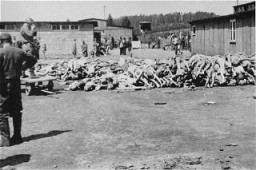
A Polish former inmate of Auschwitz identifies Oswald Pohl while on the stand for the prosecution during the Pohl/WVHA trial. This trial, case #4 of the Subsequent Nuremberg Proceedings, took place in a room in the Palace of Justice which was not the main courtroom. Nuremberg, Germany, April 18, 1947.
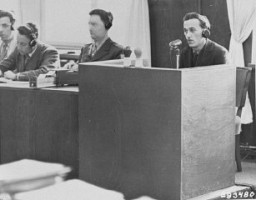
The Greinegger family, shown here in a formal portrait, were prosperous farmers in northern Austria. During World War II, the son died as a soldier in the German army. The second youngest daughter, Frieda, spent almost two years in Ravensbrück concentration camp for consorting with a Polish forced laborer, Julian Noga. Frieda and Julian married after the war. Place and date of photograph uncertain.
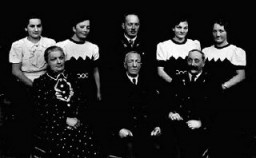
A prosecution witness demonstrates the position prisoners were forced to assume for punishment on the whipping block in the Dachau concentration camp. The Dachau concentration camp trial opened in November 1945. Photograph taken between November 15 and December 13, 1945, Dachau, Germany.
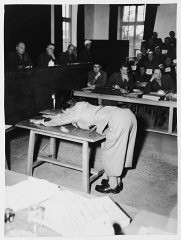
Displaced persons protest the forced return to Germany of passengers from the refugee ship Exodus 1947. British Foreign Secretary Ernest Bevin is hanged in effigy. Photograph taken by Henry Ries. Hohne-Belsen, Germany, September 7, 1947.
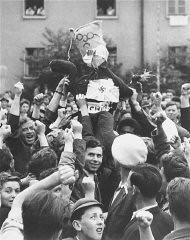
An exhausted Jewish woman from the Exodus 1947 refugee ship is given a drink as British soldiers stand nearby. The British forcibly returned the passengers to Europe. Haifa, Palestine, July 19, 1947.
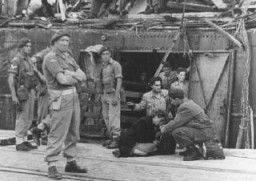
The Anciaux family with Annie and Charles Klein (front), Jewish children whom they sheltered during the war. Brussels, Belgium, between 1943 and 1945. Carle Enelow and Yettanda Stewart (born Charles and Annie Klein) were Jewish siblings who were hidden during the war by the family of Emile Anciaux, a Belgian Catholic. Charles and Annie's parents were deported from Mechelen (Malines) to Auschwitz, where they were murdered (their father on October 31, 1942, and their mother on January 15, 1944). After the…
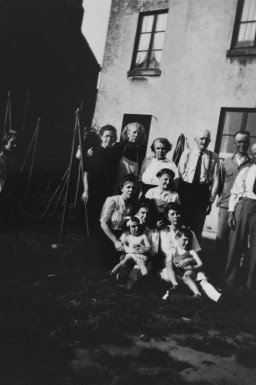
Gertruda Babilinska with Michael Stolovitzky, a Jewish boy she hid. Yad Vashem recognized her as Righteous Among the Nations. Vilna, 1943.
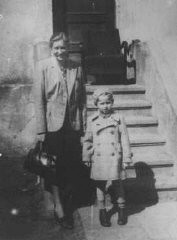
A school class of girls in Oradour. All of the children pictured were killed by the SS during the June 10, 1944, massacre. Oradour-sur-Glane, France, photograph taken 1942–43.
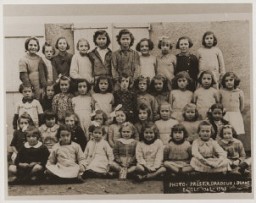
British soldiers check Jewish refugees from Aliyah Bet ("illegal" immigration) ship Theodor Herzl before deporting them to detention camps in Cyprus. Haifa port, Palestine, April 24, 1947.
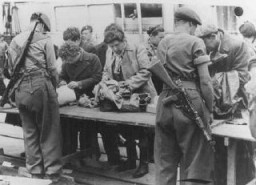
A US soldier with liberated prisoners of the Mauthausen concentration camp. Austria, May 1945.
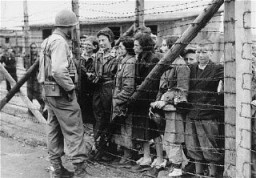
Soon after liberation, a Soviet physician examines Auschwitz camp survivors. Poland, February 18, 1945. This photograph is a still image from Soviet film of the liberation of Auschwitz.

Portrait of a Soviet soldier standing on a heavily damaged street in Budapest. Photograph taken by Soviet photographer Yevgeny Khaldei. The location is Apponyi Square. On either side of the street are the ruins of the Clotild Palaces. In the background is the Erzsebet (Elizabeth) bridge. Budapest, Hungary, 1945.
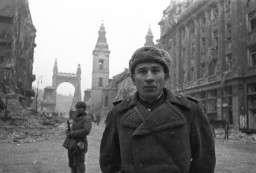
A survivor in Wöbbelin. The soldier in the foreground of the photograph wears the insignia of the 8th Infantry Division. Along with the 82nd Airborne Division, on May 2, 1945, the 8th Infantry Division encountered the Wöbbelin camp. Germany, May 4-5, 1945.
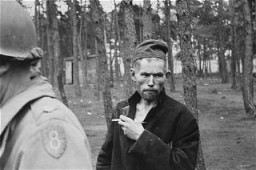
A survivor of the Bergen-Belsen camp, photographed soon after liberation. Bergen-Belsen, Germany, after April 12, 1945.
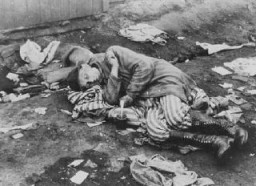
An survivor of the Bergen-Belsen camp, after liberation. Bergen-Belsen, Germany, after April 15, 1945.

A survivor of Kaufering IV, one of the Dachau subcamps in the Landsberg-Kaufering area, with US soldiers after liberation. Kaufering, Germany, after April 27, 1945.
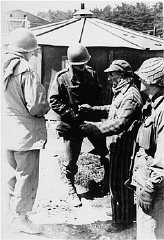
Bonde Gaza, a Hungarian musician who survived the Gardelegen atrocity, demonstrates to American soldiers how he managed to escape from the barn which the SS had set on fire. Germany, April 14–18, 1945.
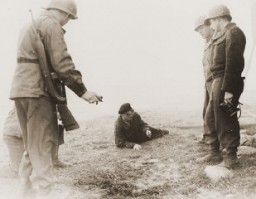
A former concentration camp prisoner receives care from a mobile medical unit of the United Nations Relief and Rehabilitation Administration. Photograph taken at the Bergen-Belsen displaced persons camp. Germany, May 1946.
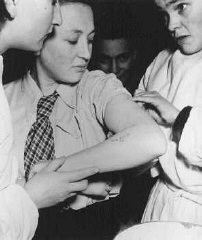
A US PT (Patrol Torpedo) boat off the coast of New Guinea, during an American counteroffensive against Japanese advances in the Solomon Islands in the eastern Pacific Ocean, 1943.
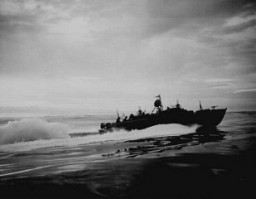
An American GI using his steel helmet to draw water from a stream during the Battle of the Bulge. December 22, 1944. US Army Signal Corps photograph taken by J Malan Heslop.
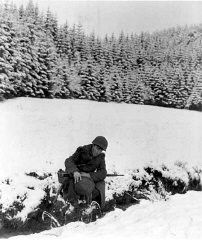
A US soldier stands among the corpses of prisoners exhumed from a mass grave in a ravine near Nammering. On April 19, 1945, a freight train with nearly 4,500 prisoners from Buchenwald pulled onto the railroad siding at Nammering. Hundreds of prisoners who had died on the train were buried in the mass grave along with the prisoners who were forced to carry the corpses to the ravine and were then shot. Germany, ca. May 6, 1945.

Following the Axis invasion of Yugoslavia in April 1941, Hungarian authorities in Novi Sad began confiscating property from Jewish families. The city's synagogue served as a warehouse for the stolen goods.
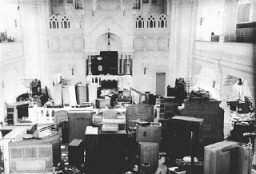
A victim of a Nazi medical experiment is immersed in icy water at the Dachau concentration camp. SS doctor Sigmund Rascher oversees the experiment. Germany, 1942.
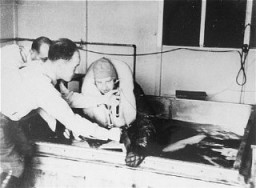
We would like to thank Crown Family Philanthropies, Abe and Ida Cooper Foundation, the Claims Conference, EVZ, and BMF for supporting the ongoing work to create content and resources for the Holocaust Encyclopedia. View the list of donor acknowledgement.